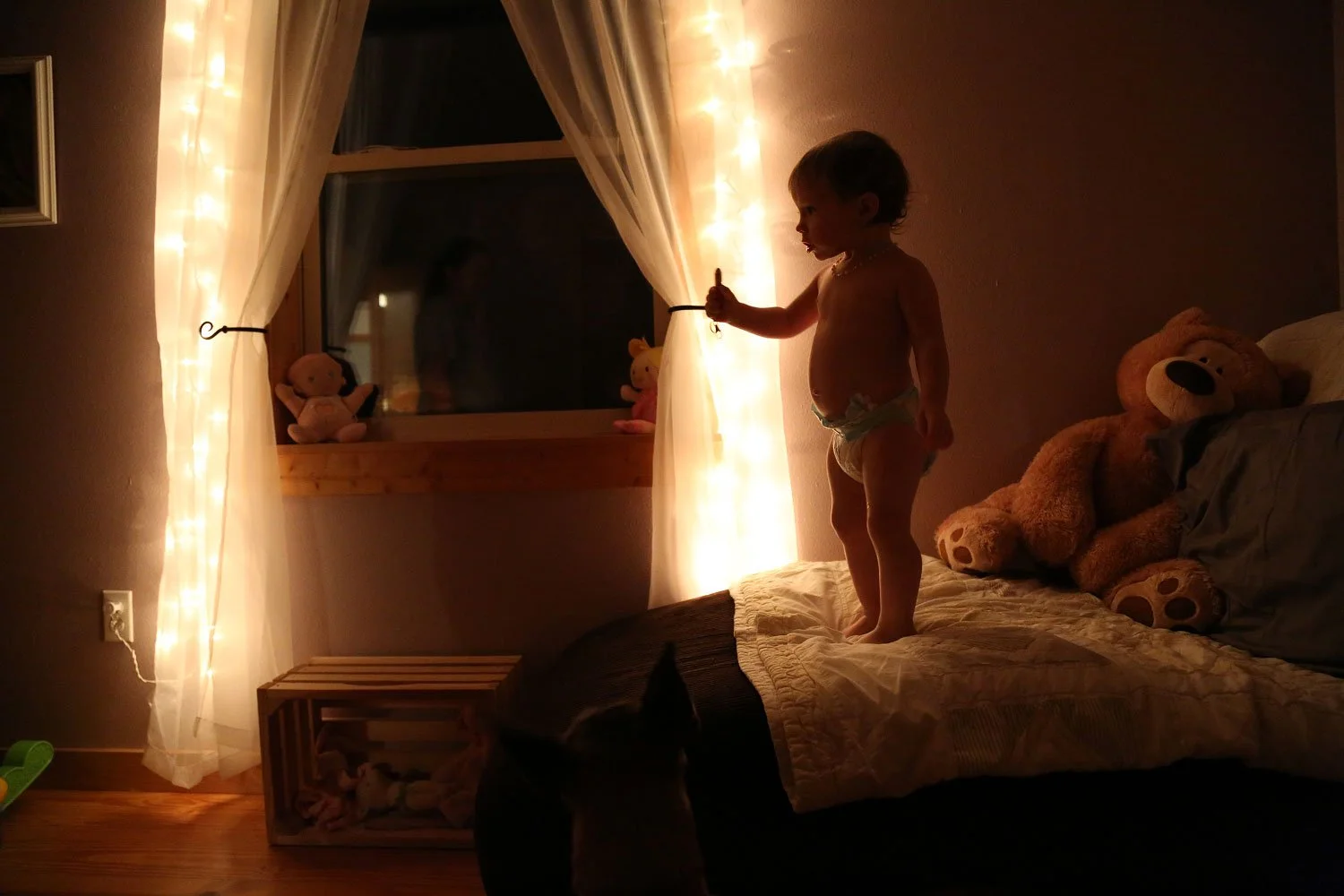What to do when your toddler won’t sleep: 10 tips that work

Clinically reviewed by Dr. Chris Mosunic, PhD, RD, MBA
Frustrated that your toddler won’t sleep? Learn why sleep struggles happen, what might be keeping them up, and 10 practical tips to make them stay in bed and sleep.
When your baby was a newborn, you might have wondered if you’d ever sleep through the night again. And then, of course, you did! Maybe you breathed a sigh of relief — or even felt a little smug when your parent-friends complained about how tired they were.
But then it hits you: toddler sleep woes.
Out of nowhere, your little one might reject the bedtime routine that you so carefully constructed. Instead of letting you put them down as you always had, suddenly they’re singing to themselves for hours, calling out to you in the middle of the night, or, perhaps most frustratingly, refusing to stay in bed.
Sound familiar?
Sleep issues in toddlers are common and, like the children themselves, wildly unpredictable. One night, they go to bed fairly easily, and the next, they refuse to put on their pajamas, no matter what you do. It’s exhausting, infuriating, and often feels like you’re doing something wrong.
You’re not. Toddlers resist sleep for all kinds of reasons that have nothing to do with your parenting and everything to do with their rapidly developing (and often dysregulated) brains. Here’s everything you need to know about why toddlers resist sleep, and more importantly, what you can actually do about it.
Why toddlers resist sleep (and why it’s totally normal)
Toddler sleep resistance is nearly universal, so you’re not alone if your kid is fighting you at bedtime. Here are some reasons why it happens.
Separation anxiety is real: Around 18 months to 3 years, many toddlers experience a surge of separation anxiety. Their understanding of object permanence deepens. They know you’re still out there when they can’t see you, and that realization can feel terrifying to them.
They’re overtired: The more exhausted toddlers are, the harder it can be for them to fall asleep. Cortisol and other stress hormones can spike when they’re overtired, making them wired and cranky. On the flip side, if they’ve napped too long or too late, they could then not be ready to settle.
Stimulation doesn’t shut off easily: Bright lights, screen time, and loud toys can leave their brain in overdrive. Unlike adults, toddlers can’t always calm down on their own. Often, they need help moving from active play to restful sleep, and if they don’t get that buffer, falling asleep can feel impossible.
They’re testing boundaries: Many toddlers are trying to figure out how much power they have, and nothing invites a power struggle like bedtime. To feel like they have some sort of control, they might say no, delay lights-out, or ask for “just one more” snack or story.
Big transitions disrupt little sleep: Major life changes like moving, starting daycare, or welcoming a new sibling can destabilize their sleep. In fact, even exciting milestones can be overwhelming. When things feel uncertain during the day, sleep is often the first thing to unravel.
Their sleep needs are changing: Toddler sleep isn’t one-size-fits-all. Some kids start dropping naps earlier than others. Some suddenly need more nighttime sleep after a growth spurt. What worked two weeks ago might suddenly stop working. All this means is that their bodies and brains are growing, and that’s normal.
How to deal when your toddler won’t sleep: 10 ways to ease bedtime battles
If you're tired of battling at bedtime, there are manageable ways you can get your toddler to sleep without having to wave your white flag.
Here are 10 ways you can make bedtime more peaceful — for both of you.
1. Stick to a consistent wind-down routine
Toddlers crave predictability. A reliable bedtime routine tells their bodies and brains that sleep is coming, even if they say they’re not tired.
Try a simple, 20-30 minute routine with the same steps in the same order each night. You could do bath, pajamas, two books, snuggles, and then lights out.
Here are eight tips to help you establish a bedtime routine for your toddler.
💙 Take your toddler on a trip to the rainforest by listening to Azul’s Sleepy Rainforest with Julie Aigner Clark.
2. Adjust nap and bedtime timing
Overtired toddlers can have a harder time falling and staying asleep, but too much daytime sleep can backfire, too. Most toddlers do best with:
1–3 hours of nap time (until age 3–4)
Bedtime between 7–8 p.m.
10–12 hours of nighttime sleep
Also, if your toddler takes a long nap and is suddenly wide awake at 9pm, try capping naps or moving bedtime later by 15–30 minutes.
Read more: What makes a good bedtime routine for kids? 10 do’s and don’ts
3. Make the bedroom feel safe and cozy
A dark, quiet, and cool room can help cue them that it’s time for sleep, but toddlers also need to feel safe. This is where a favorite stuffy or a nightlight can help.
4. Set firm but gentle boundaries
Sometimes, giving them a little bit of control can go a long way. Hold boundaries while still offering choices.
Try saying to them, “It’s bedtime now. Do you want to hop like a bunny to your bed or tiptoe like a mouse?” Giving a controlled choice helps your child feel involved without derailing the routine. And if they resist, stay calm and repeat the routine script like a broken record, “It’s bedtime. I’ll tuck you in now.”
5. Plan “special time” before bedtime
Sometimes, bedtime resistance is a bid for more connection. To reduce clinginess later on, build in 10–15 minutes of undivided attention earlier in the evening. You could play, snuggle, or build something together. You might even say, “This is our time to hang out, just you and me, before we do the bedtime steps.”
Read more: 101 fun questions to ask your kid to strengthen your bond
6. Keep night wakings boring and brief
When your toddler wakes in the middle of the night, keep your interactions uneventful. Use a quiet, low voice, avoid turning on lights or engaging in play, and offer brief comfort. You could say, “You’re safe, and it’s time to sleep.”
7. Introduce a toddler clock or bedtime visual
Visual cues can help toddlers understand the concept of time.
Consider getting your child a clock that changes color to show them when it’s time to get up. Then you can say, “When the clock turns green, you can get out of bed.”
You could also have routine charts, which are simple pictures that show each bedtime step, such as brushing teeth and putting on pajamas.
8. Name the hard stuff
Toddlers aren’t always able to articulate what’s wrong. Help them label their feelings. You could say, “You’re feeling mad that it’s bedtime,” or “You’re worried about being alone.”
Naming emotions gives kids tools to understand what’s going on and eventually cope. You can also pair this with reassurance and say, “I’ll be right in the next room, and you’re safe here.”
9. Build a “goodnight basket” or ritual
Create a calming ritual that tells them it’s time for bed to give them a sense of closure and comfort.
You could make a goodnight basket with books they only get at bedtime, or make up a goodnight poem that you recite together.
💙 Listening to Raggedy Ann Stories with Margo Trueblood can help your little one settle down.
10. Forgive yourself and start fresh tomorrow
Some nights, nothing works — and that’s okay. If this happens, be kind to yourself and repair things with your child if necessary. You’ll both start again tomorrow.
Toddler won't sleep FAQs
How can I get my toddler to sleep through the night?
Having a predictable bedtime routine can help your toddler wind down and feel safe. This can include dim lighting, quiet time with no screens, and a consistent order of activities, like bath, books, and cuddles. You’ll also want to make sure their sleep schedule supports good nighttime rest, which may require you to move their bedtime or adjust their nap schedule.
If your toddler wakes in the night, try to respond calmly and keep the interactions minimal. Simply reassure them that they’re safe, guide them back to bed, and avoid turning on bright lights or engaging too much.
How can I get my toddler to stay in bed all night?
If your toddler refuses to stay in bed, consider using a toddler clock that signals when it’s okay to get up. This can give them a visual cue they can understand.
Still, not every child will respond to this. When they get up, calmly walk them back with as little fanfare as possible. You can also repeat the same script each time, like, “It’s bedtime. I’ll see you in the morning.” This can help reinforce the boundary without turning it into a power struggle.
Is it normal for toddlers to fight bedtime?
It is very normal for toddlers to fight bedtime due to factors like separation anxiety and overstimulation.
Also, at this age, toddlers are learning how to assert their independence (though they still crave attention). Bedtime battles are just a sign that your toddler is growing, stretching, and testing their limits.
How do I improve my toddler’s sleep without sleep training?
If you’d like to improve your toddler’s sleep without sleep training, here are a few approaches you can take:
Focus on consistency, routine, and emotional regulation.
Create a predictable bedtime sequence that signals safety and calm.
Offer extra connection during the day and before bed to reduce clinginess.
When night wakings happen, respond with reassurance, but avoid habits that become unsustainable, like needing to be rocked for hours.
When should I worry about my toddler’s sleep?
Most sleep struggles in toddlers are normal and will pass with time, consistency, and support. With that said, there are a few red flags to watch for. For example, if your child snores loudly, gasps for air, or stops breathing briefly during sleep, this could mean they have sleep apnea and should see a pediatrician.
Also, it might be worth reaching out to a healthcare provider if they keep sleeping for less than 8–9 hours a night or if they consistently have daytime sleepiness despite getting enough rest.
Calm your mind. Change your life.
Mental health is hard. Getting support doesn't have to be. The Calm app puts the tools to feel better in your back pocket, with personalized content to manage stress and anxiety, get better sleep, and feel more present in your life.





